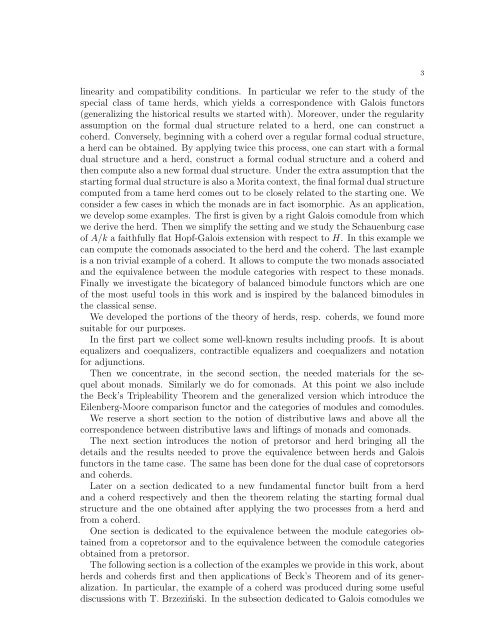Contents 1. Introduction 2 2. Preliminaries 4 2.1. Some results on ...
Contents 1. Introduction 2 2. Preliminaries 4 2.1. Some results on ...
Contents 1. Introduction 2 2. Preliminaries 4 2.1. Some results on ...
Create successful ePaper yourself
Turn your PDF publications into a flip-book with our unique Google optimized e-Paper software.
linearity and compatibility c<strong>on</strong>diti<strong>on</strong>s. In particular we refer to the study of thespecial class of tame herds, which yields a corresp<strong>on</strong>dence with Galois functors(generalizing the historical <str<strong>on</strong>g>results</str<strong>on</strong>g> we started with). Moreover, under the regularityassumpti<strong>on</strong> <strong>on</strong> the formal dual structure related to a herd, <strong>on</strong>e can c<strong>on</strong>struct acoherd. C<strong>on</strong>versely, beginning with a coherd over a regular formal codual structure,a herd can be obtained. By applying twice this process, <strong>on</strong>e can start with a formaldual structure and a herd, c<strong>on</strong>struct a formal codual structure and a coherd andthen compute also a new formal dual structure. Under the extra assumpti<strong>on</strong> that thestarting formal dual structure is also a Morita c<strong>on</strong>text, the final formal dual structurecomputed from a tame herd comes out to be closely related to the starting <strong>on</strong>e. Wec<strong>on</strong>sider a few cases in which the m<strong>on</strong>ads are in fact isomorphic. As an applicati<strong>on</strong>,we develop some examples. The first is given by a right Galois comodule from whichwe derive the herd. Then we simplify the setting and we study the Schauenburg caseof A/k a faithfully flat Hopf-Galois extensi<strong>on</strong> with respect to H. In this example wecan compute the com<strong>on</strong>ads associated to the herd and the coherd. The last exampleis a n<strong>on</strong> trivial example of a coherd. It allows to compute the two m<strong>on</strong>ads associatedand the equivalence between the module categories with respect to these m<strong>on</strong>ads.Finally we investigate the bicategory of balanced bimodule functors which are <strong>on</strong>eof the most useful tools in this work and is inspired by the balanced bimodules inthe classical sense.We developed the porti<strong>on</strong>s of the theory of herds, resp. coherds, we found moresuitable for our purposes.In the first part we collect some well-known <str<strong>on</strong>g>results</str<strong>on</strong>g> including proofs. It is aboutequalizers and coequalizers, c<strong>on</strong>tractible equalizers and coequalizers and notati<strong>on</strong>for adjuncti<strong>on</strong>s.Then we c<strong>on</strong>centrate, in the sec<strong>on</strong>d secti<strong>on</strong>, the needed materials for the sequelabout m<strong>on</strong>ads. Similarly we do for com<strong>on</strong>ads. At this point we also includethe Beck’s Tripleability Theorem and the generalized versi<strong>on</strong> which introduce theEilenberg-Moore comparis<strong>on</strong> functor and the categories of modules and comodules.We reserve a short secti<strong>on</strong> to the noti<strong>on</strong> of distributive laws and above all thecorresp<strong>on</strong>dence between distributive laws and liftings of m<strong>on</strong>ads and com<strong>on</strong>ads.The next secti<strong>on</strong> introduces the noti<strong>on</strong> of pretorsor and herd bringing all thedetails and the <str<strong>on</strong>g>results</str<strong>on</strong>g> needed to prove the equivalence between herds and Galoisfunctors in the tame case. The same has been d<strong>on</strong>e for the dual case of copretorsorsand coherds.Later <strong>on</strong> a secti<strong>on</strong> dedicated to a new fundamental functor built from a herdand a coherd respectively and then the theorem relating the starting formal dualstructure and the <strong>on</strong>e obtained after applying the two processes from a herd andfrom a coherd.One secti<strong>on</strong> is dedicated to the equivalence between the module categories obtainedfrom a copretorsor and to the equivalence between the comodule categoriesobtained from a pretorsor.The following secti<strong>on</strong> is a collecti<strong>on</strong> of the examples we provide in this work, aboutherds and coherds first and then applicati<strong>on</strong>s of Beck’s Theorem and of its generalizati<strong>on</strong>.In particular, the example of a coherd was produced during some usefuldiscussi<strong>on</strong>s with T. Brzeziński. In the subsecti<strong>on</strong> dedicated to Galois comodules we3
















